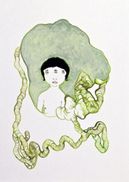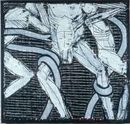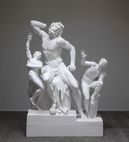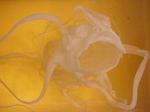Good art gore post on Modern Art Notes, here. MAN’s Tyler Green went looking for intestines at the Philadelphia Art Museum and found plenty.
One of his comparisons, however, doesn’t quite make the grade – Jeff Wall’s
Dead Troops Talk (a vision after an ambush of a Red Army Patrol, near Moqor, Afghanistan, Winter 1986) with Caravaggio’s The Incredulity of St Thomas.
Dave Hickey forged the link that matters between contemporary art and Caravaggio’s Incredulity in The Invisible Dragon: Essays on Beauty from 1991, long out of print and now available in a reissue, here. Specifically, in a chapter titled, Nothing Like the Son, Hickey compared Incredulity with Robert Mapplethorpe’s photo of a man sticking his finger in his penis. (Images and text of this chapter here.)
Wall’s work is remote. That’s its signature. It’s cold to its core. In contrast, Caravaggio’s painting and Mapplethorpe’s photo are all about touch. Both are as perverse as they are seductive.
John Berger wrote about Caravaggio’s voluptuous intimacy two decades before Hickey, the electric charge of the boy Cupid’s wing resting his thigh, but Hickey found its present-day equivalent in the work of an artist not credited with it. Before Hickey, Mapplethorpe was seen as stylishly meticulous. The kink in his content didn’t change that, but Hickey did.
The pre-Hickey view of Mapplethorpe was instantly out-of-date. The book was a game-changer, plus big fun to read. Back to intestines. In art, a writhing form is a writhing form.
(Click images to enlarge.)
In Sabrina Small’s Duality, intestines are the equivalent of umbilical chords:
In Michael Spafford, they’re a fatal form of father-son bonding:
In Kris Martin, they’re present in their absence.
In Masami Teraoka, they’re octopuses.

In Karen Liebowitz, a horn.
In Claude Zervas, they’re a river.










Fun post! Yeah, my Caravaggio link wasn’t so much meant to compare Wall to Caravaggio, but to point out a key source of intestinal exploration. Caravaggio wasn’t the first painter to do spilling guts, but his theatrical, sly realism works on about 23 levels in his Thomas. And I think it’s fair to say that it has many, many descendants.